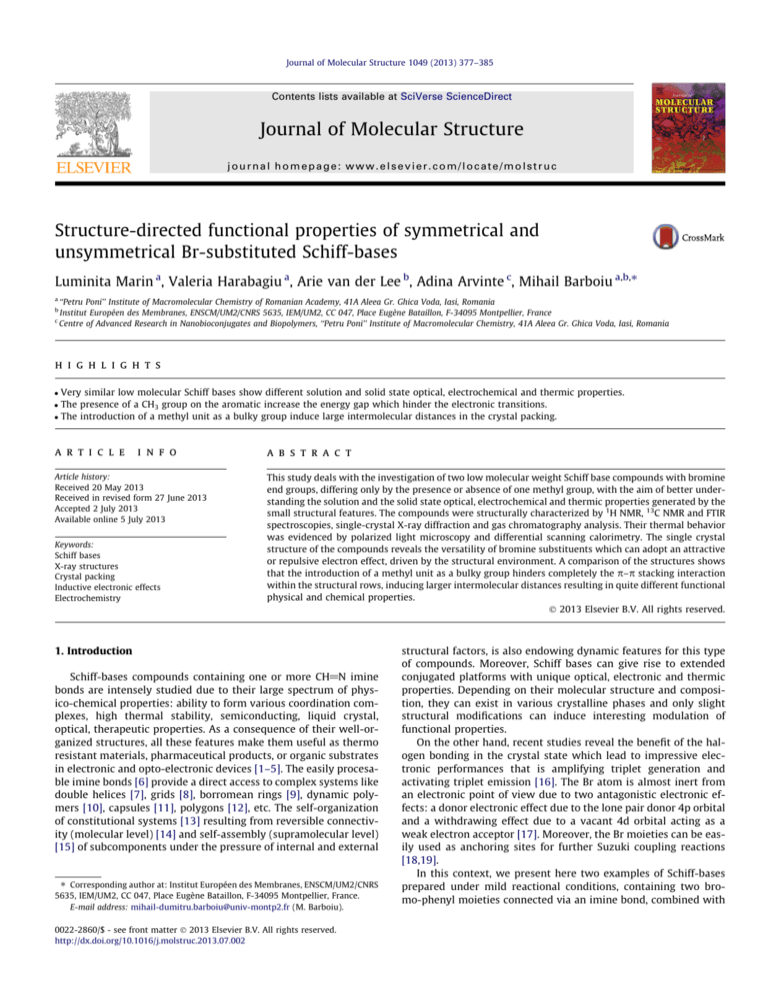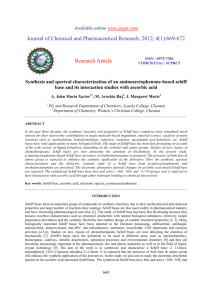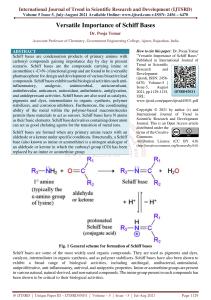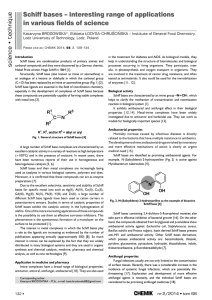
Journal of Molecular Structure 1049 (2013) 377–385
Contents lists available at SciVerse ScienceDirect
Journal of Molecular Structure
journal homepage: www.elsevier.com/locate/molstruc
Structure-directed functional properties of symmetrical and
unsymmetrical Br-substituted Schiff-bases
Luminita Marin a, Valeria Harabagiu a, Arie van der Lee b, Adina Arvinte c, Mihail Barboiu a,b,⇑
a
‘‘Petru Poni’’ Institute of Macromolecular Chemistry of Romanian Academy, 41A Aleea Gr. Ghica Voda, Iasi, Romania
Institut Européen des Membranes, ENSCM/UM2/CNRS 5635, IEM/UM2, CC 047, Place Eugène Bataillon, F-34095 Montpellier, France
c
Centre of Advanced Research in Nanobioconjugates and Biopolymers, ‘‘Petru Poni’’ Institute of Macromolecular Chemistry, 41A Aleea Gr. Ghica Voda, Iasi, Romania
b
h i g h l i g h t s
Very similar low molecular Schiff bases show different solution and solid state optical, electrochemical and thermic properties.
The presence of a CH3 group on the aromatic increase the energy gap which hinder the electronic transitions.
The introduction of a methyl unit as a bulky group induce large intermolecular distances in the crystal packing.
a r t i c l e
i n f o
Article history:
Received 20 May 2013
Received in revised form 27 June 2013
Accepted 2 July 2013
Available online 5 July 2013
Keywords:
Schiff bases
X-ray structures
Crystal packing
Inductive electronic effects
Electrochemistry
a b s t r a c t
This study deals with the investigation of two low molecular weight Schiff base compounds with bromine
end groups, differing only by the presence or absence of one methyl group, with the aim of better understanding the solution and the solid state optical, electrochemical and thermic properties generated by the
small structural features. The compounds were structurally characterized by 1H NMR, 13C NMR and FTIR
spectroscopies, single-crystal X-ray diffraction and gas chromatography analysis. Their thermal behavior
was evidenced by polarized light microscopy and differential scanning calorimetry. The single crystal
structure of the compounds reveals the versatility of bromine substituents which can adopt an attractive
or repulsive electron effect, driven by the structural environment. A comparison of the structures shows
that the introduction of a methyl unit as a bulky group hinders completely the p–p stacking interaction
within the structural rows, inducing larger intermolecular distances resulting in quite different functional
physical and chemical properties.
Ó 2013 Elsevier B.V. All rights reserved.
1. Introduction
Schiff-bases compounds containing one or more CH@N imine
bonds are intensely studied due to their large spectrum of physico-chemical properties: ability to form various coordination complexes, high thermal stability, semiconducting, liquid crystal,
optical, therapeutic properties. As a consequence of their well-organized structures, all these features make them useful as thermo
resistant materials, pharmaceutical products, or organic substrates
in electronic and opto-electronic devices [1–5]. The easily procesable imine bonds [6] provide a direct access to complex systems like
double helices [7], grids [8], borromean rings [9], dynamic polymers [10], capsules [11], polygons [12], etc. The self-organization
of constitutional systems [13] resulting from reversible connectivity (molecular level) [14] and self-assembly (supramolecular level)
[15] of subcomponents under the pressure of internal and external
⇑ Corresponding author at: Institut Européen des Membranes, ENSCM/UM2/CNRS
5635, IEM/UM2, CC 047, Place Eugène Bataillon, F-34095 Montpellier, France.
E-mail address: mihail-dumitru.barboiu@univ-montp2.fr (M. Barboiu).
0022-2860/$ - see front matter Ó 2013 Elsevier B.V. All rights reserved.
http://dx.doi.org/10.1016/j.molstruc.2013.07.002
structural factors, is also endowing dynamic features for this type
of compounds. Moreover, Schiff bases can give rise to extended
conjugated platforms with unique optical, electronic and thermic
properties. Depending on their molecular structure and composition, they can exist in various crystalline phases and only slight
structural modifications can induce interesting modulation of
functional properties.
On the other hand, recent studies reveal the benefit of the halogen bonding in the crystal state which lead to impressive electronic performances that is amplifying triplet generation and
activating triplet emission [16]. The Br atom is almost inert from
an electronic point of view due to two antagonistic electronic effects: a donor electronic effect due to the lone pair donor 4p orbital
and a withdrawing effect due to a vacant 4d orbital acting as a
weak electron acceptor [17]. Moreover, the Br moieties can be easily used as anchoring sites for further Suzuki coupling reactions
[18,19].
In this context, we present here two examples of Schiff-bases
prepared under mild reactional conditions, containing two bromo-phenyl moieties connected via an imine bond, combined with












